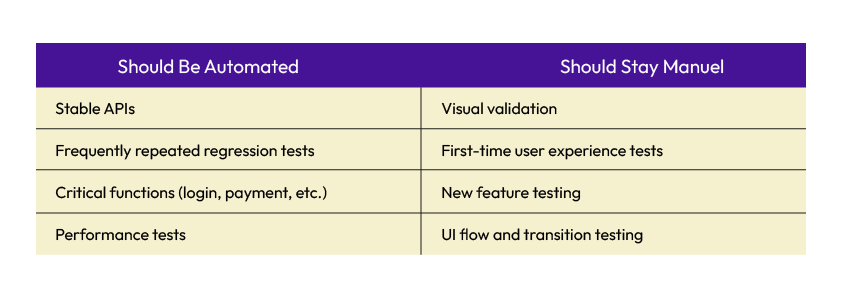When it comes to test automation, the first instinct for many companies is to automate everything. While this seems efficient in theory, it often proves unsustainable in real-world projects.
If we truly want to increase efficiency in our testing processes, we need to ask this simple question: Do we really need to automate everything?
Not All Automation Adds Value
Test automation is highly effective in repetitive and time-consuming tasks like regression. However, trying to automate every single test case can lead to wasted time and resources.
Where automation truly adds value:
• Stable and rarely changing functionalities
• Critical workflows that require frequent testing (e.g., login, payment)
• API and integration tests
• Performance testing
On the other hand, areas like user experience, visual validation, or brand-new features are often better suited for manual testing, which can be more agile and intuitive.
To summarize this distinction more clearly, here’s a quick comparison:

Is Your Strategy Realistic?
Many teams start with the dream of “a test suite that covers everything”—only to end up tangled in an unsustainable automation web. A realistic strategy considers not just technology, but these important questions:
• How frequently does the application change?
• Who will write and maintain the automation scripts?
• Is the team technically capable and supported?
• Does automating this test really add meaningful value?
A Real-World Example
At an e-commerce company based in Turkiye, the test engineering team decided to automate the entire payment flow using Playwright. Initially, the test scenarios ran successfully. But within just three weeks, a minor UI update on the payment page caused the entire test suite to break.
Rather than constantly updating broken tests, the team shifted their strategy:
• Only the stable API-level parts of the payment process remained automated.
• UI and UX tests returned to manual testing.
As a result, test execution time decreased, error rates dropped, and the team could focus more on exploratory and user-centric testing.
This real-world case clearly shows:
“The goal of automation is not to cover everything — but to cover what truly matters.”
Conclusion: Do Less, Achieve More
In test automation, being realistic means asking not just “Can we automate this?” but also “Should we?” A good automation strategy blends technical skills with intuitive thinking, business goals, and an understanding of team capacity.
Remember:
“Test automation is a tool — not the goal.”

